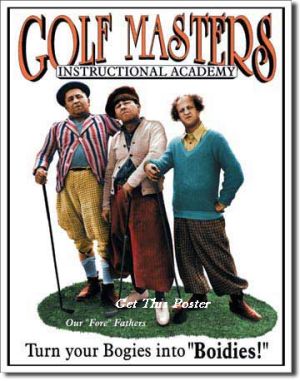This is the 2nd part of "Golf As a Dancer Sees It."
"Yes I can see that. If I tighten my shoulders I immediately lose the feel of torsion at the waist."
"Again," I said, "if your shoulders and waist lose their flexible passivity, you can no longer retard your shoulders so that they will follow down, bringing the club head."
Her eyebrows went up again at that! "But you don't mean to say that I should or can retard my shoulders, do you?" she asked.
"Oh yes you can, and what is more, you must. The elastic waist and the consequent retarded shoulders have as much to do with the 'flailing' action as has the breaking back of the wrists. One is the counterpart of the other; it is the whole action that constitutes the flail."
"I see that. But you are always insisting on the upward stretch. How can I stretch up through the body without actively lifting my shoulders?"
"You must stretch up with legs and hips, and then the shoulders will come up passively. Try it and you will see. When you try deliberately and directly to raise your shoulders, you commit one of golf's gravest faults. Keeping the shoulders up must be a reactive movement, reactive to the brace of the body. And now that we have cleared the ground a bit, let us return to your image of the upright pillar and the circles. The upright pillar stands for our 'power-stretch/1 suppose."
"Yes that is it."
"And the circles?"
"Well, they give us a sense of never moving any member of our body except around the pillar. But they also convey to me a sense of continuity in movement. Circles are continuous lines and represent the unbroken continuity of the whole movement. Also, what you good players do not seem to realize is that you make your movements one after another, never altogether. That gives me the image of a set of spirals moving progressively upward right out to the club head."
"Yes?" said I, interested.
"Yes. And I think it is this connecting together in progression that makes the golf feel so difficult to acquire. I feel it as a force which comes out of the ground, gets into my feet, climbs up my legs and hips, passes on through shoulders and arms, and so to the club head. Only, by the time I feel it has reached the club head, the club head is a couple of feet past the ball. That is what I mean by continuity."
"Oh is it!" I gasped and then when I got my second wind, "But that sounds to me less like continuity than acceleration."
"Maybe," she said. "But if it is a gathering up of power, it is essentially a continuous gathering up. Each feel in the whole movement is joined in unison to the forthcoming one-anticipating it one might say."
"But do you suggest that the feel precedes the movement?" I asked.
"Of course I do. You know it does. You told me to prepare my feel as I walked to the tee, as I waggled. What is that but anticipation? You fellows excel because you anticipate. You know the correct feels and their correct succession, and you step up to a ball conscious and confident of what will happen. So there is nothing to hamper your swing, no hesitation and no hurry; the anticipation has established the correct continuous feels in you."
"How did you come to know that?" I asked, conscious that she was perfectly correct.
"Well," she smiled, "you may remember that I not only dance, I teach and therefore analyze dancing. Dancing is movement, and movement is life; so you must not be surprised if my analyzing has gone beyond my own sphere and trespassed into yours! And I was right, wasn't I?"
This concludes Percy Boomer's anecdote on how a dancer sees golf... and how accurate her analyzis was!



